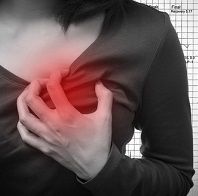Mammograms Can Also Predict Heart Disease
In a potentially practice-changing finding, New York researchers found mammograms can predict coronary arterial calcifications and heart disease risk.

Mammograms can detect more than cancer, New York City researchers have found. They can also predict heart disease.
A novel quantitative investigation of the role of breast arterial calcification (BAC) in prediction of coronary artery calcification (CAC) to be presented Sunday April 3rd at the American College of Cardiology’s 65th Annual Scientific Session and Expo ACC.16 reveals digital mammography screenings contain unreported early indicators of cardiac disease.
Not only did analysis show a strong quantitative association between BAC and CAC, BAC proved superior to standard cardiovascular risk factors Framingham Risk Score (FRS) and 2013 Cholesterol Guidelines Pooled Cohort Equations (PCE). Researchers recommend a large prospective outcomes-based trial to further evaluate BAC’s predictive power
Co-author Laurie Margolies, MD, of the Icahn School of Medicine at Mt Sinai NY underlined the significance and economy of what she described as “potentially practice-changing and life-changing research presenting a practical, accessible way of assessing a woman’s risk of cardiovascular disease” speaking in an American College of Cardiology webinar March 22.
“Many women fear breast cancer much more than they fear heart disease,” Margolies said.“We don’t routinely screen for coronary artery disease- yet it kills many more women than breast cancer,” she said, yet “By adding no cost, no radiation, and little time we can find calcification in these vessels.
Commenting on the findings in an interview, Khurram Nasir, MD, research director of the Center for Prevention and Wellness and director of the High-Risk Cardiovascular Disease Clinic at Baptist Health South Florida, Miami, FL breaks new ground.
"The most important finding of the study was its robust positive predictive value of nearly 70% for identifying women with the presence of coronary artery calcification," Nasir said.
That means that about 10 percent of women who get mammograms in the US annually will likely have signs of premature coronary atherosclerotic disease, and can be referred for care.
The Mount Sinai study, Digital Mammography and Screening for Coronary Artery Disease compared BAC to CAC in 325 asymptomatic women including 33 with known CAD, undergoing mammography and CT scan within 1 year, and compared BAC to FRS and PQE.
BAC was found in 42.5% of the women and was related to age, hypertension and kidney disease. CAC was found in 47.6% of the women.
The sensitivity, specificity, positive and negative predictive values, and accuracy of BAC >0 for CAC >0 were 63%, 76%, 70%, 69%, and 70%, respectively.
The multivariable odds ratio for CAC >0 was 3.2 for BAC 4 to 12, 2.0 for age, and 2.2 for hypertension; i.e., BAC was more powerful than standard risk factors.
The agreements of FRS risk categories with CAC and BAC risk categories were 57% for CAC and 55% for BAC; the agreement was 47% for PCE risk categories for CAC and 54% by BAC.
BAC >0 had area under the curve of 0.73 for identification of women with CAC >0, equivalent to both FRS (0.72) and PCE (0.71).
BAC >0 increased the area under the curves for FRS (0.72 to 0.77; p = 0.15) and PCE (0.71 to 0.76; p =0.11) for the identification of high-risk (4 to 12) CAC.
With the inclusion of 33 women with established CAD, BAC >0 was significantly additive to both FRS (p =0.02) and PCE (p =0.04) for high-risk CAC.
Lead author Harvey S. Hecht, MD, professor at the Icahn School of Medicine at Mount Sinai, director of cardiovascular imaging at Mount Sinai St. Luke’s Hospital will present Digital Mammography and Screening for Coronary Artery Disease, which will be published simultaneously in JACC: Cardiovascular Imaging